In April I wrote that American has started offering dynamically priced awards. This is allowing for lower-priced awards than American was previously offering, but doesn’t generally allow for getting a ‘good deal’.
- American still has an award chart
- But they’re also offering awards for fewer miles than the award chart says
- When they do this it’s generally tied to the price of a ticket, still providing a low value per mile (but better than the old price would have been)
Two months ago the airline acknowledged dynamic award pricing publicly for the first time.
American’s Senior Vice President of Revenue Management Don Casey said dynamic pricing of awards is a strategy they’re using to drive higher revenue from the loyalty program. More mileage redemptions means recognizing more deferred revenue, and redemptions at a higher mileage price does too.
We’re starting to see this more and more. JonNYC tweeted the new example of the Minneapolis – Chicago market.
We’re seeing prices as low as 5000 miles each way in coach. These are for ‘economy saver’ awards which cannot be changed (they can be cancelled with miles redeposited, for a fee).
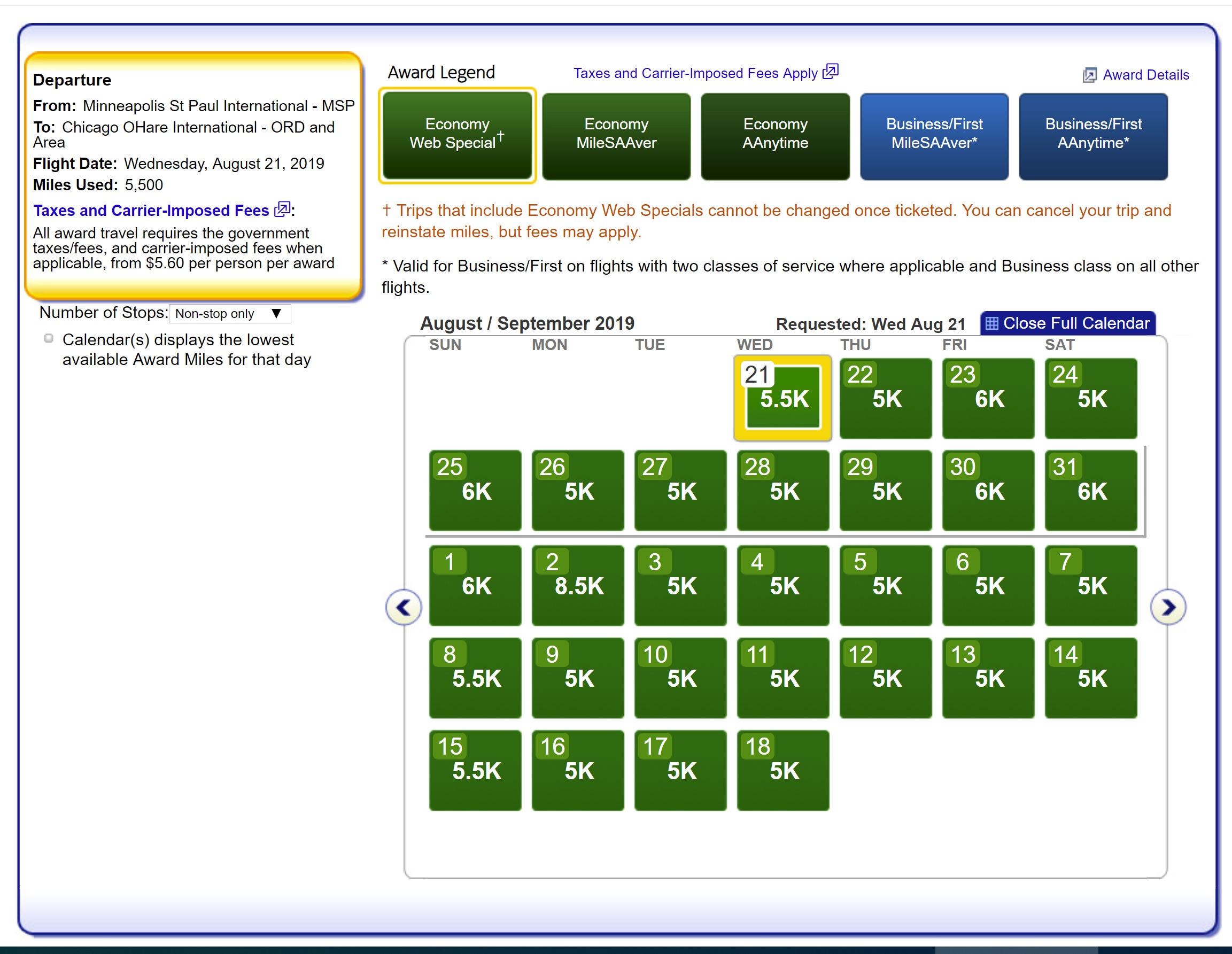
That’s great, right? Just 5000 miles for a flight. In fact, the cost varies depending on which flight you choose on a given day. Looking at September 4 prices range from 5000 miles to 20,000 miles. The old ‘AAnytime’ award pricing was 20,000 for non-peak times.
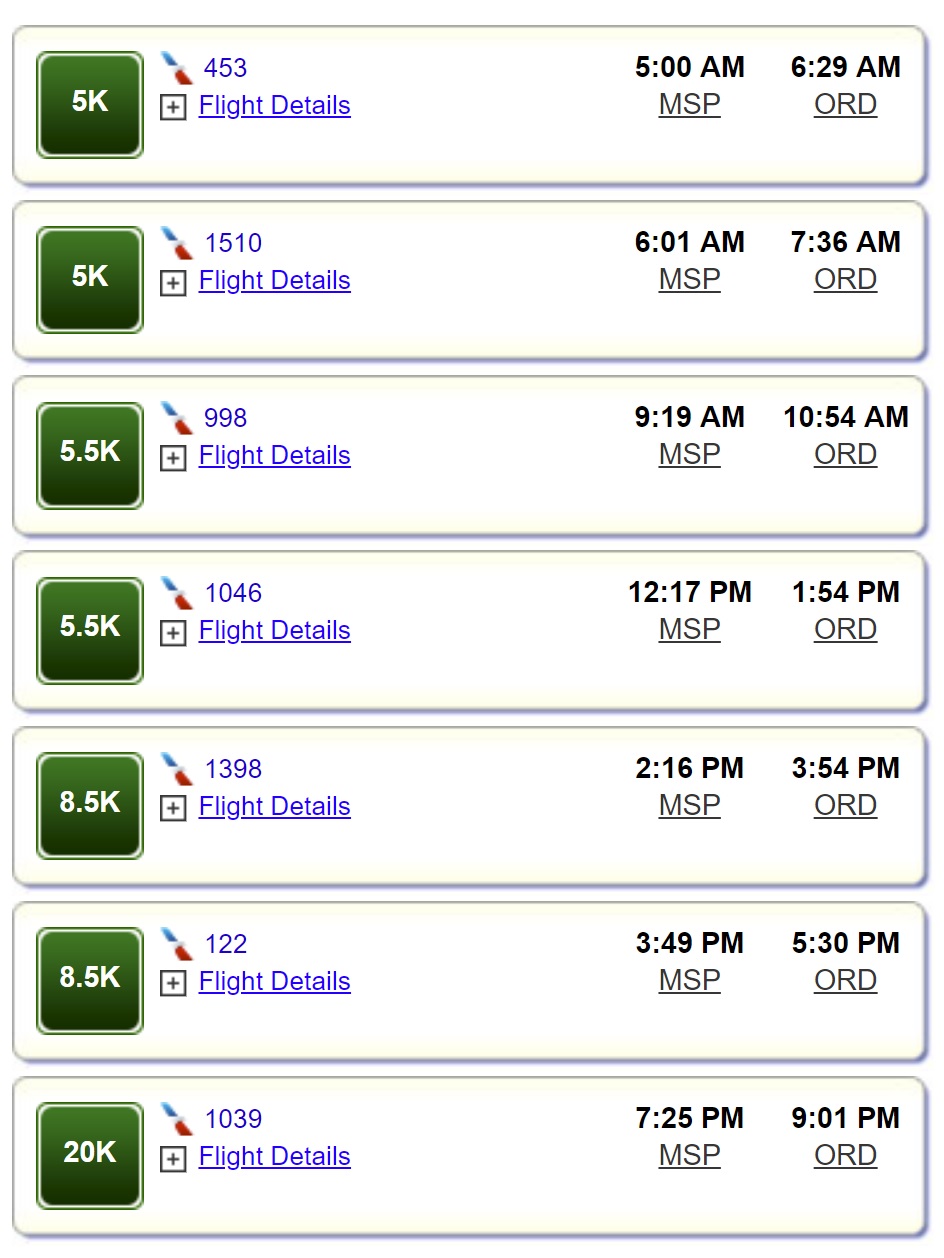
The prices for these same flights start at $59 and run up to $183.
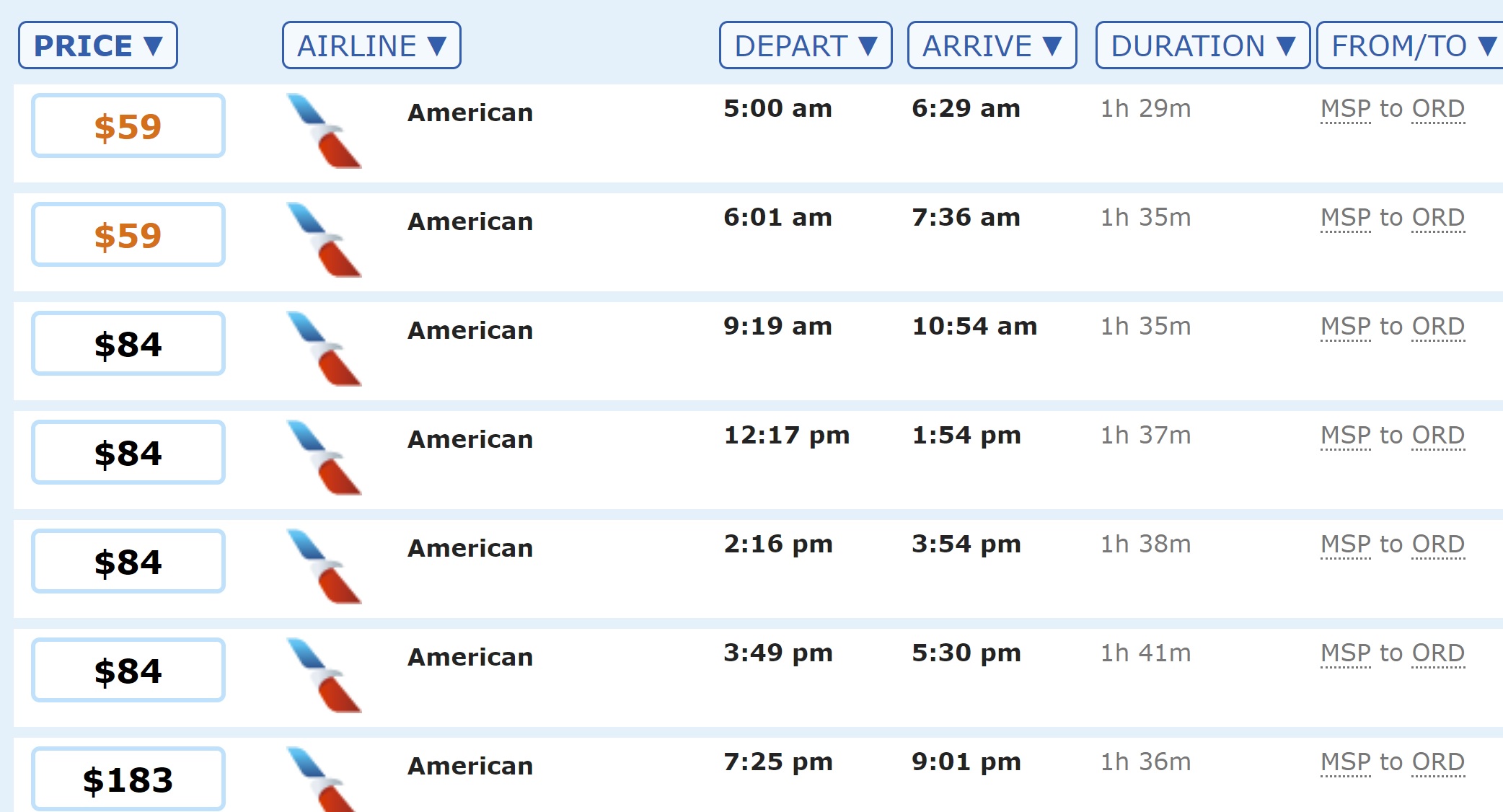
So when you do the math, you’re not actually getting much per mile. However so far so good, we’ve seen this since last fall although back then you were more likely to find deals netting you two cents apiece for your miles.
Here’s where you see premium cabin awards available, domestic first class on the Minneapolis – Chicago route is showing up for 15,000 miles (due to the short length of the flight).
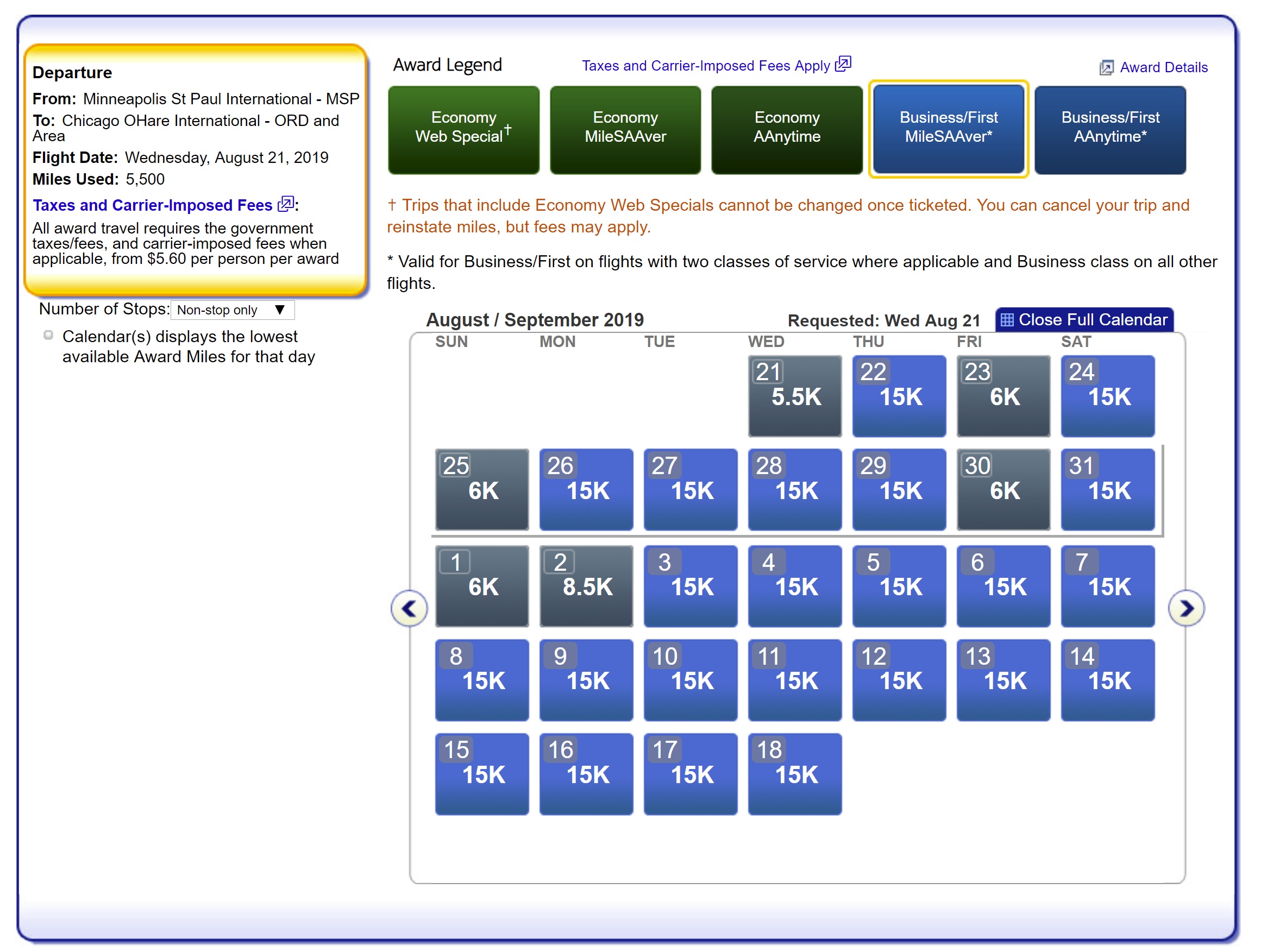
If you drill down, only two of the flights on the same day – September 4 – have saver inventory and are available at this price.
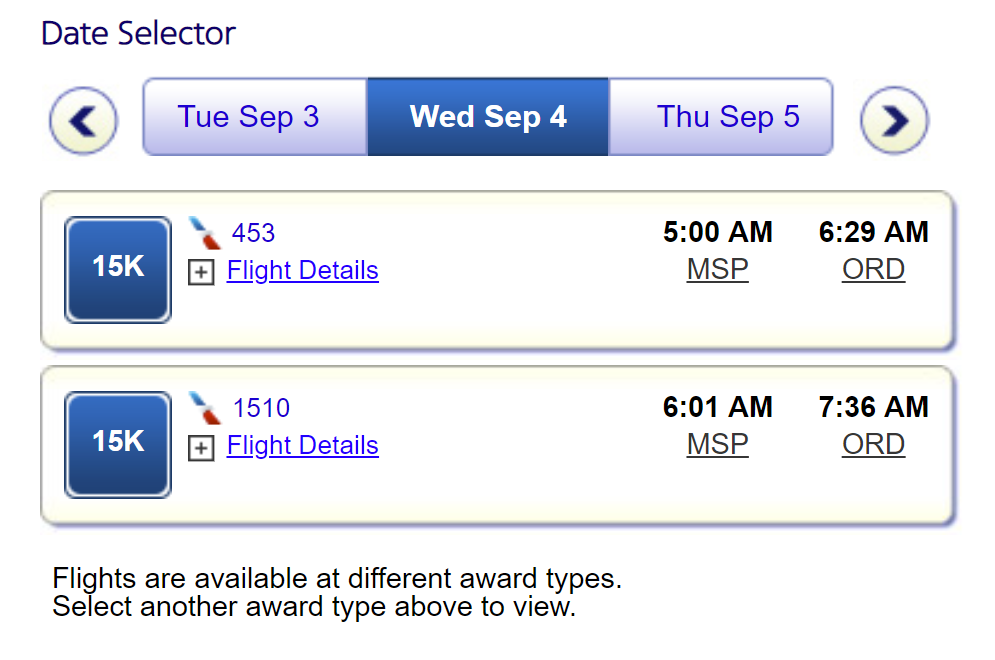
Those are the two flights being sold at the cheapest price — $193. Again, even at this discounted price you’re getting less than 1.3 cents per mile.
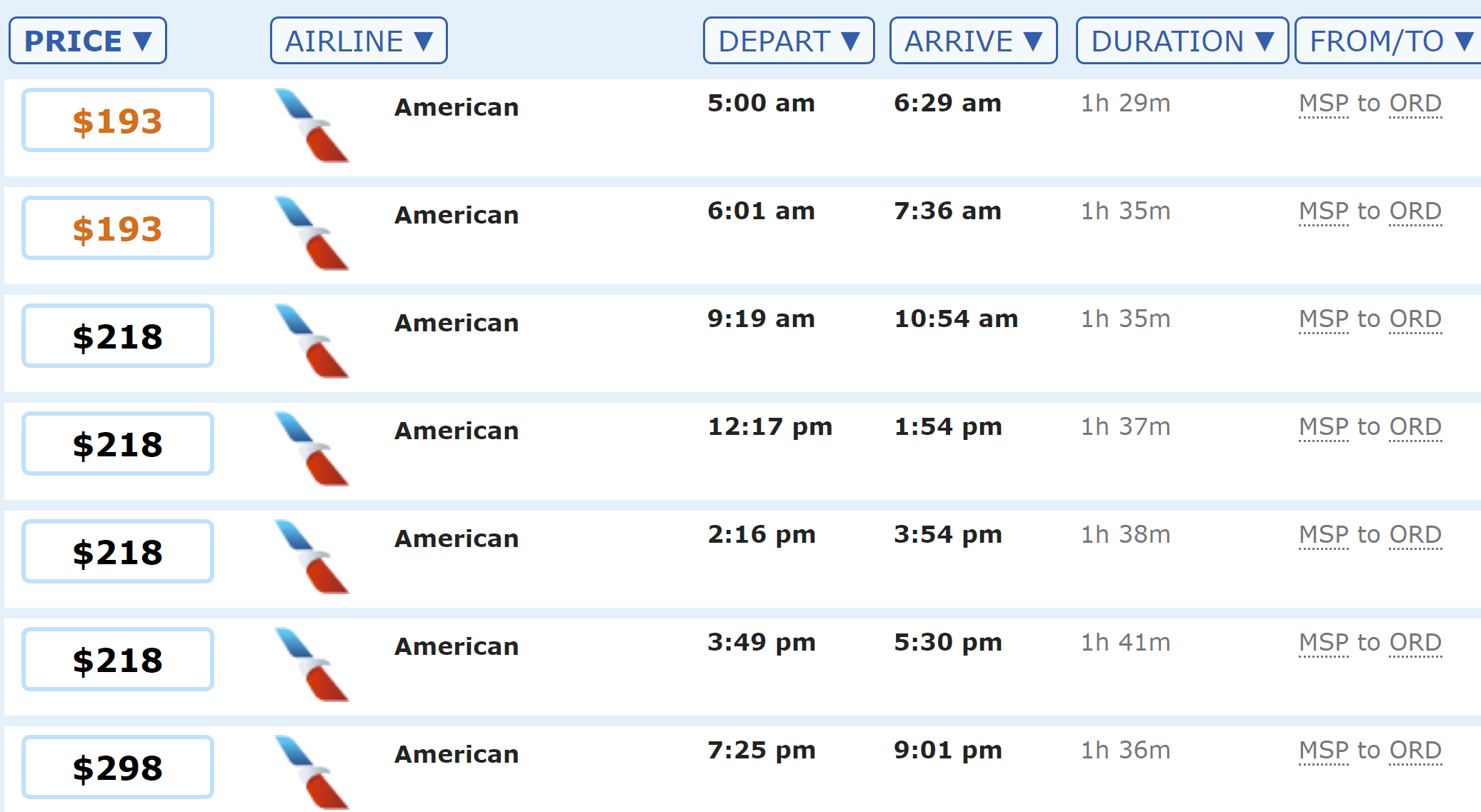
The other more expensive tickets cost 45,000 miles, or less than half a cent per mile. 15,000 is better in the George W. Bush ‘soft bigotry of low expectations’ kind of way.
Revenue-based redemptions are about delivering more award availability to avoid frustrating members, but where miles have a consistent and low average value. It’s no wonder that they converge around one cent per mile since that’s how much liability the airline books for future travel when miles are award for flying (the liability is recorded much lower for miles earned through credit cards).
Ultimately revenue-based redemptions put frequent flyer programs on a collision course with themselves because they solve the availability problem (too many miles chasing too few seats) by treating each mile as a small amount of cash to buy paid airline tickets.
That’s costly to the airline because they may be giving up revenue they’d earn selling tickets. But it’s bad for members because it also spells the end of the inspiring reasons that fuel collecting the currency in the first place.
Updated to clarify that the 15,000 mile domestic first pricing is because of the sub-500 mile distance of the flight.


Gary,
As you have been saying for years, best use of AA miles is for International business/first class travel on partner airlines. I redeemed my last AA miles (80K per ticket for 240K total) for 3 tickets on JAL for first class from Tokyo-Chicago last week. Booked them about 10 and 6 days before flying (AA showed 2 tickets at 10 days out and then another 1 at 6 days). Cost about $100 each with the close in booking fee and taxes. 12.5 hours of pure flying bliss. I drank an entire bottle of Salon 2003, most of a bottle of Cristal, Chivas Royal 21, ate like an animal and slept for a few hours. Crew was absolutely perfect. Cabin was kept fairly cool as well. Best flight ever. I have just accepted this as the new normal and have stopped trying to find the AA metal “needle in the haystack” saver award.
Do you find it beneficial to your audience to include unnecessary political references?
There’s something else going on too, that I’ve seen with short notice flights. Consider MSY-CLT for tomorrow (Friday). With the short notice, cash price is $365 one way for any of the six nonstops. Anytime award is 50K. Saver economy is unavailable. But all six flights offer Economy Web Specials for 7K. So that’s 5+ cents value per mile.
(When I looked at this route last week, I was seeing 6K, yielding 6 cpm. )
Point being, the economy web specials aren’t just very low miles prices on flights with very low cash prices.
Yes, the popular flights are in the .009/point value range which makes miles nearly worthless. In markets that are predominately not direct flights the layovers are typically long sometimes nearly a day to fly across country. Red eyes are usually at a steep discount to vacation destinations like Orlando but the mileage requirement triples if you want a morning departure that arrives before midnight. This new award structure might works for old folks with lots of time and backpackers who don’t mind sleeping on airport floors but it’s certainly punitive and not efficient. AA plans these routes to discourage bookings and to sell you up to reasonable departure and arrival times. Even air freight moves across the country faster than AA scheduling.The better solution is to fly SWA. No overnight or long connections with reasonable award values.
@tired of the political commentary – what exactly are you objecting to? I think there’s an idea that a former U.S. president expressed that’s apropos here, seemed to frame the issue well.
The cpm thing is a concern of the bloggers and the FT world. It has little to do with how the general passenger makes mileage redemption decision. It ignores the value of the alternate use of the dollars that would have been spend on the ticket. It ignores the fact that for a lot of people the cost to acquire the miles is essentially zero.
I am excited about these changes. Sure, the best ‘per cent’ usages is on premium cabin partner flights, followed by premium cabin saaver awards on long haul flights; but what about the huge number of Aadvantage members that -aren’t- corporate road warrior flyers with ‘first class’ tastes. We -aren’t- collecting the tens to hundreds of thousands of miles to make such “valuable’ redemptions possible for ourselves plus family for ‘aspirational trips’ in premium cabins (and even if we were to accumulate such high a number miles, most of us still bulk at throwing them all at a single flight in F or J — It may be sacriligious here, but trust me, most Americans really don’t see much value in the premium cabin — flying is about getting there, and spending tens of thousand of extra miles or thousand(s) of dollars for a bigger lie flat seat and a cheap amenity kit sure looks like flushing hard earned money straight down the drain). Aadvantage needs to offer more useful ways for the casual flyer to redeem pts for trips to see family members, or a quick domestic romantic trip with the spouse. Right now, domestic saaver redemptions aren’t offered very often (especially with routings that make any sense), and when they do it is only because the cash price is so cheap and the redemptions still don’t bring the value of a mile very often to much above 1 cent per mile anyways. Dropping the floor lower is a welcome change at opening redemption options. These changes open the door to get SOMETHING out of our miles.
If legacy airlines want revenue-based earning and redemption-based redemptions, they are effectively giving you a ~5% credit on tickets for future flights (the amount obviously varies based on elite status and fare class).
At that point, they could disband the loyalty program altogether and lower ticket costs accordingly, but they enjoy having infrequent flyers paying for miles they’ll never use – it’s pure profit for them. But at the same time, AA is trying to compete with LCC’s who offer cheaper tickets in lieu of miles of any value (Southwest being the exception). And even with the introduction of Basic Economy, AA still has that fare earn miles.
In short, AA can’t decide if it wants to be a full-service airline or not; it’s simply a “have your cake and eat it too” strategy.
@Pat, that goes both ways. Every airline out there with the exception of Southwest and Allegiant wants to be an everything airline. The Big Boys want to have basic economy, and the ULCC’s have their big seats in the front.
This is not necessarily always bad.
I recently saw SFO-DFW for 6k miles at ~1.5 cpp. I had to book 3 tickets and the price increased slightly to 19.5k for all 3, still over 1.5 cpp.
I was quite happy with the redemption.
There are occasionally good deals out there. Bought a last minute one way LAX-OKC for 17k when the one way cash fare was over $700. Sure as hell beats the usual 30-50k AA would normally charge.
Airlines have reached the “dump” phase of pump and dump.
The airlines forget, I still have a Discover card. No need to buy miles using my credit card if the redemption rate is revenue based. Get cash back, and buy tickets with cash.